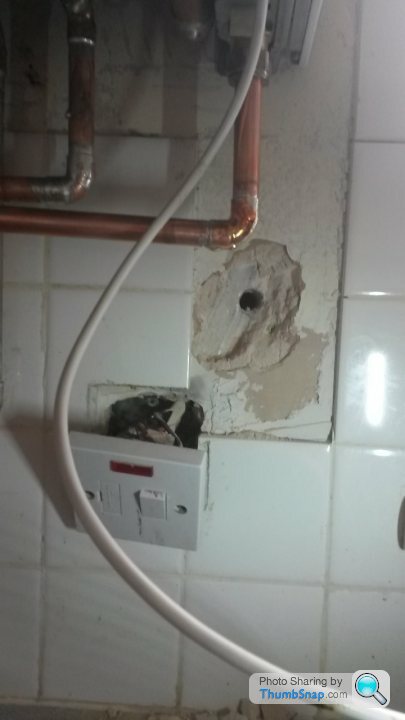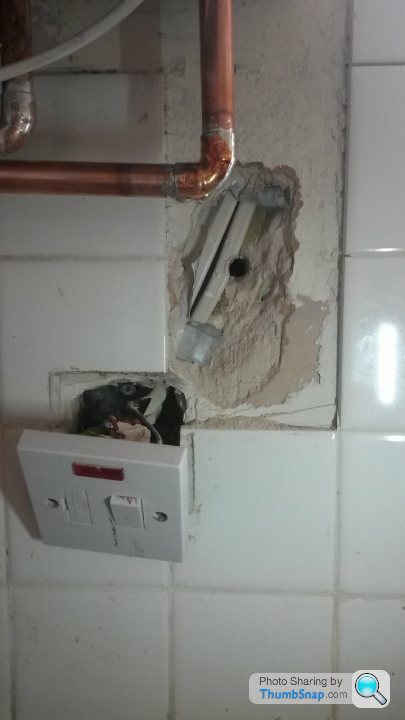Channeling cable into blockwork- conduit required?
Discussion
Alucidnation said:
And how do you think bonding is applied?
TBH, all of what you have typed there is complete s t.
t.
For thin chases I use a putty knife for the bonding... As helpful as "complete sTBH, all of what you have typed there is complete s
 t.
t. t" is, would you mind giving some actual information to back yourself up please
t" is, would you mind giving some actual information to back yourself up please 
I am happy to be corrected, but I speak from my experience, I had a house fully rewired by a sparky and plastered it all myself.
When you bond, there is no reason to press down hard,, you are just pushing in bonding to a few mm below the surface, with no concern for it to look pretty, likewise when skimming, you are not pushing hard until nearer the end when its setting. A twin and earth is not made of jelly, it would need to be hit with pressure at an angle to nick it.
So as I said, in my view you would have to be pretty useless to do it.
Edited by hyphen on Thursday 15th December 22:22
227bhp said:
You have zero chance of pulling a cable through a nailed/screwed on cable cover. The ones that allow you to do that are tubular conduit.
It is a bit of a waste of time really, I can see no advantage at all, it just looks a bit better before it's covered over.
I've rewired plenty of houses using existing capping routes although it is a pain and you have to be careful and tie on properly. However just use the oval conduit, it's hardly expensive and probably quicker to install than clipping the cables to soft blockIt is a bit of a waste of time really, I can see no advantage at all, it just looks a bit better before it's covered over.
OP, just ask the sparks how much more for conduit, it shouldn't be much, if any more
227bhp said:
You have zero chance of pulling a cable through a nailed/screwed on cable cover. The ones that allow you to do that are tubular conduit.
It is a bit of a waste of time really, I can see no advantage at all, it just looks a bit better before it's covered over.
I recently replaced a TV antenna cable with coax and network by pulling it through a metal cable cover.It is a bit of a waste of time really, I can see no advantage at all, it just looks a bit better before it's covered over.
I also managed to do move a plug in the kitchen about 300-400mm by pulling the cable slack through.
So, slightly higher than zero chance, in my experience.
hairyben said:
227bhp said:
You have zero chance of pulling a cable through a nailed/screwed on cable cover. The ones that allow you to do that are tubular conduit.
.
You should probably go spend a little time with a decent spark if you want to go telling the world what can and cant be done pal. .
I've seen plenty of 2.5 t&e clipped to walls and then covered over with a flimsy cover, single cables I can see being pulled through, but not that.
Any experienced electrician when asked about pulling cables up walls will tell you he'll give it a go for 10 mins or charge for more, but it's more than likely than not he won't be succeeding.
Walls (should) be drilled with masonary bits. Drilling a cable is easy with a masonary bit. A masonary bit will not drill metal or plastic conduit easily unlike a hss drill bit. Hence capping or oval conduit offers a greater protection to the cables from being drilled later, plus allows for a chance of rewiring unlike direct clip and plaster over. It costs pennies to add capping or oval conduit.
227bhp said:
I'm no pal of yours.
I've seen plenty of 2.5 t&e clipped to walls and then covered over with a flimsy cover, single cables I can see being pulled through, but not that.
Any experienced electrician when asked about pulling cables up walls will tell you he'll give it a go for 10 mins or charge for more, but it's more than likely than not he won't be succeeding.
I guess youre not, being constantly corrected would be quite unpleasant.I've seen plenty of 2.5 t&e clipped to walls and then covered over with a flimsy cover, single cables I can see being pulled through, but not that.
Any experienced electrician when asked about pulling cables up walls will tell you he'll give it a go for 10 mins or charge for more, but it's more than likely than not he won't be succeeding.
I suggest you find a decent sparks, in honesty a dying breed as the trade is dumbed down (I was lucky enough to get a proper old school apprenticeship with the blokes who taught you all the tricks and made you go the extra mile) and prepare to be amazed.
speedyman said:
Walls (should) be drilled with masonary bits. Drilling a cable is easy with a masonary bit. A masonary bit will not drill metal or plastic conduit easily unlike a hss drill bit.
Have you ever used a drill? A hot masonary drill will go through plastic like butter. Metal capping will be pierced in no time- if you're experienced you can feel a pressure change as the metal bounces or hear the metallic rattle before it punches through but you have to be quick.hairyben said:
227bhp said:
I'm no pal of yours.
I've seen plenty of 2.5 t&e clipped to walls and then covered over with a flimsy cover, single cables I can see being pulled through, but not that.
Any experienced electrician when asked about pulling cables up walls will tell you he'll give it a go for 10 mins or charge for more, but it's more than likely than not he won't be succeeding.
I guess youre not, being constantly corrected would be quite unpleasant.I've seen plenty of 2.5 t&e clipped to walls and then covered over with a flimsy cover, single cables I can see being pulled through, but not that.
Any experienced electrician when asked about pulling cables up walls will tell you he'll give it a go for 10 mins or charge for more, but it's more than likely than not he won't be succeeding.
I suggest you find a decent sparks, in honesty a dying breed as the trade is dumbed down (I was lucky enough to get a proper old school apprenticeship with the blokes who taught you all the tricks and made you go the extra mile) and prepare to be amazed.
227bhp said:
I wouldn't be amazed, I was there in those times too. We used to do a lot of hospital contacts, as you maybe know (and forgive my nomenclature) it was all hand bent 1" galv tube, done by hand on one of those pipe benders on a stand, then hand threaded and wound together with threaded couplers - that was slow work and chasing it into often very hard brick walls a foul job too, although the sparks wouldn't touch that bit, the builders or apprentices used to get that to do.
To be fair theres a lot of industrial background sparks who've come a cropper thinking domestic would be a piece of P because the theories simple when in reality a different set of skills are needed and nothing beats experience. And of course vice versa. Whatever you did with galv tube is as relevent to rewire skills as being certified on a 747 is to riding a motorbike, cos they both have engines and wheels.227bhp said:
hairyben said:
227bhp said:
You have zero chance of pulling a cable through a nailed/screwed on cable cover. The ones that allow you to do that are tubular conduit.
.
You should probably go spend a little time with a decent spark if you want to go telling the world what can and cant be done pal. .
I've seen plenty of 2.5 t&e clipped to walls and then covered over with a flimsy cover, single cables I can see being pulled through, but not that.
Any experienced electrician when asked about pulling cables up walls will tell you he'll give it a go for 10 mins or charge for more, but it's more than likely than not he won't be succeeding.
hairyben said:
speedyman said:
Walls (should) be drilled with masonary bits. Drilling a cable is easy with a masonary bit. A masonary bit will not drill metal or plastic conduit easily unlike a hss drill bit.
Have you ever used a drill? A hot masonary drill will go through plastic like butter. Metal capping will be pierced in no time- if you're experienced you can feel a pressure change as the metal bounces or hear the metallic rattle before it punches through but you have to be quick.speedyman said:
hairyben said:
speedyman said:
Walls (should) be drilled with masonary bits. Drilling a cable is easy with a masonary bit. A masonary bit will not drill metal or plastic conduit easily unlike a hss drill bit.
Have you ever used a drill? A hot masonary drill will go through plastic like butter. Metal capping will be pierced in no time- if you're experienced you can feel a pressure change as the metal bounces or hear the metallic rattle before it punches through but you have to be quick.speedyman said:
hairyben said:
speedyman said:
Walls (should) be drilled with masonary bits. Drilling a cable is easy with a masonary bit. A masonary bit will not drill metal or plastic conduit easily unlike a hss drill bit.
Have you ever used a drill? A hot masonary drill will go through plastic like butter. Metal capping will be pierced in no time- if you're experienced you can feel a pressure change as the metal bounces or hear the metallic rattle before it punches through but you have to be quick.
speedyman said:
hairyben said:
speedyman said:
Walls (should) be drilled with masonary bits. Drilling a cable is easy with a masonary bit. A masonary bit will not drill metal or plastic conduit easily unlike a hss drill bit.
Have you ever used a drill? A hot masonary drill will go through plastic like butter. Metal capping will be pierced in no time- if you're experienced you can feel a pressure change as the metal bounces or hear the metallic rattle before it punches through but you have to be quick.

metal capping. plumber drilled through with masonry bit, cos it's a brick wall innit, shaved the red only, RCD failed to work (check 'em folks), plumber knew nothing until he stuffed a bit of 15mm copper tube into the hole and got thrown across the room.
Gassing Station | Homes, Gardens and DIY | Top of Page | What's New | My Stuff



